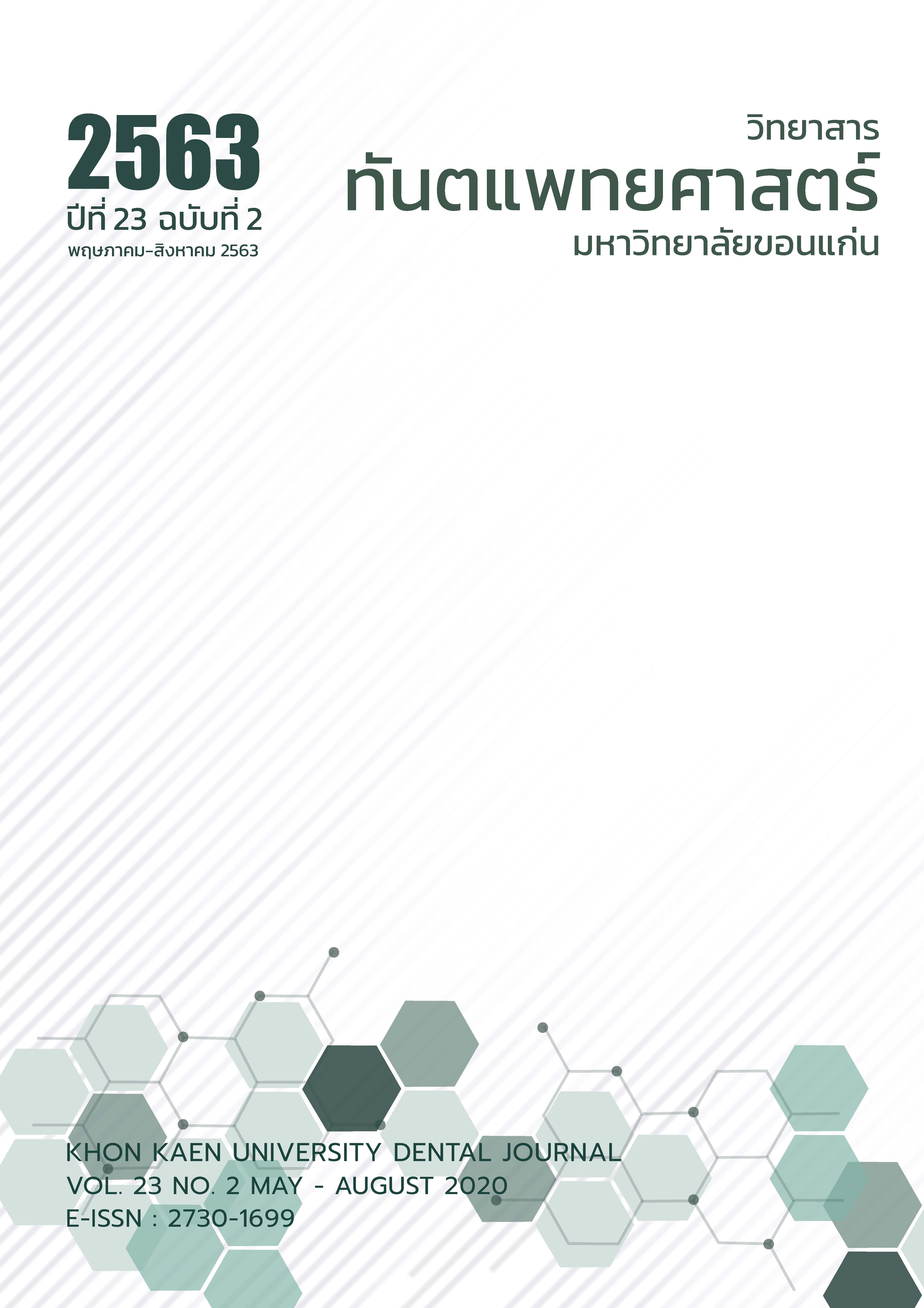The Stability of Immediate Implant Placement in Posterior Region: a Six-Month Study
Main Article Content
Abstract
The purpose of this study was to evaluate implant stability change during the healing period after immediate implant placement, in order to determine the appropriate time for implant loading in the posterior teeth. The hydrophilic SLA surface tapered implants were immediately placed after posterior teeth extraction. The stability of the implants was obtained using resonance frequency analysis, and presented using implant stability quotient (ISQ) values. The stability measurements were performed immediately after placement (0 week), and at 1 week, 2 weeks, 4 weeks, 8 weeks, 12 weeks and 24 weeks after implant placement, respectively. The implants achieved prosthesis after 6 months of placement. A total of 23 patients with 23 implants were included in this study. After immediate placement, all the implants had high primary stability (ISQ=74.03+5.63). The ISQ values were observed to be lowest 4 weeks after placement (71.82+6.17) before gradually increasing over the 24-week measurement period (81.59+3.94). There was a significant correlation (p<0.001) found between mean ISQ and time. The present study demonstrates that implant stability change is correlated with time, with all the immediate implants placed in posterior teeth having high primary stability. The implant stability gradually decreased over 4 weeks, before gradually increasing until week 20, and subsequently decreasing thereafter. During the healing period, implant stability did not decrease below an ISQ 70, indicating high stability that is sufficient for immediate loading.
Article Details
บทความ ข้อมูล เนื้อหา รูปภาพ ฯลฯ ที่ได้รับการลงตีพิมพ์ในวิทยาสารทันตแพทยศาสตร์ มหาวิทยาลัยขอนแก่นถือเป็นลิขสิทธิ์เฉพาะของคณะทันตแพทยศาสตร์ มหาวิทยาลัยขอนแก่น หากบุคคลหรือหน่วยงานใดต้องการนำทั้งหมดหรือส่วนหนึ่งส่วนใดไปเผยแพร่ต่อหรือเพื่อกระทำการใด ๆ จะต้องได้รับอนุญาตเป็นลายลักษณ์อักษร จากคณะทันตแพทยศาสตร์ มหาวิทยาลัยขอนแก่นก่อนเท่านั้น
References
Sennerby L, Meredith N. Implant stability measurements using resonance frequency analysis: biological and biomechanical aspects and clinical implications. Periodontol 2008;47(1):51-66.
Mistry G, Shetty O, Shetty S, Singh RD. Measuring implant stability: A review of different methods. J Dent Implant 2014;4:165-9.
Meredith N, Alleyne D, Cawley P. Quantitative determination of the stability of the implant-tissue interface using resonance frequency analysis. Clin Oral Impl Res 1996;7:261-7.
Debruyne S, Grognard N, Verleye G, Van Massenhove K, Mavreas D, Vannet BV. ISQ calculation evaluation of in vitro laser scanning vibrometry-captured resonance frequency. Int J Implant Dent 2017;3(1):44.
Pagliani L, Sennerby L, Petersson A, Verrocchi D, Volpe S, Andersson P. The relationship between resonance frequency analysis (RFA) and lateral displacement of dental implants: an in vitro study. J Oral Rehabil 2013;40(3):221-7.
Trisi P, Carlesi T, Colagiovanni M, Perfetti G. Implant stability quotient (ISQ) vs direct in vitro measurement of primary stability (micromotion): effect of bone density and insertion torque. J Osteol Biomat 2010;1(3):141-9.
Bornstein MM, Hart CN, Halbritter SA, Morton D, Buser D. Early loading of nonsubmerged titanium implants with a chemically modified sand‐blasted and acid‐etched surface: 6‐month results of a prospective case series study in the posterior mandible focusing on peri‐implant crestal bone changes and implant stability quotient (ISQ) values. Clin Implant Dent Relat Res 2009;11(4):338-47.
Kokovic V, Jung R, Feloutzis A, Todorovic VS, Jurisic M, Hämmerle CH. Immediate vs. early loading of SLA implants in the posterior mandible: 5-year results of randomized controlled clinical trial. Clin Oral Impl Res 2014;25:e114-9.
Rodrigo D, Aracil L, Martin C, Sanz M. Diagnosis of implant stability and its impact on implant survival: a prospective case series study. Clin Oral Implants Res 2010;21(3):255-61.
Hicklin SP, Schneebeli E, Chappuis V, Janner SF, Buser D, Brägger U. Early loading of titanium dental implants with an intra‐operatively conditioned hydrophilic implant surface after 21 days of healing. Clin Oral Implants Res 2016;27(7):875-83.
Javed F, Ahmed HB, Crespi R, Romanos GE. Role of primary stability for successful osseointegration of dental implants: Factors of influence and evaluation. Interv Med Appl Sci 2013;5(4):162-7.
Raghavendra S, Wood MC, Taylor TD. Early wound healing around endosseous implants: a review of the literature. Int J Oral Maxillofac Implants 2005;20(3): 425-31.
Hämmerle CH, Chen ST, Wilson Jr TG. Consensus Statements and Recommended Clinical Procedures Regarding the Placement of Implants in Extraction Sockets. Int J Oral Maxillofac Implants 2004;19(Suppl): 26-8.
Ketabi M, Deporter D, Atenafu EG. A systematic review of outcomes following immediate molar implant placement based on recently published studies. Clin Implant Dent Relat Res 2016; 18(6):1084-94.
Rowan M, Lee D, Pi-Anfruns J, Shiffler P, Aghaloo T, Moy PK. Mechanical versus biological stability of immediate and delayed implant placement using resonance frequency analysis. J Oral Maxillofac Surg 2015;73:253-7.
Smith RB, Tarnow DP. Classification of Molar Extraction Sites for Immediate Dental Implant Placement: Technical Note. Int J Oral Maxillofac Implants 2013;28:911-6
Vanden Bogaerde L, Sennerby L. A Randomized Case-Series Study Comparing the Stability of Implant with Two Different Surfaces Placed in Fresh Extraction Sockets and Immediately Loaded. Int J Dent 2016;2016:1-10.
Lang NP, Salvi GE, Huynh‐Ba G, Ivanovski S, Donos N, Bosshardt DD. Early osseointegration to hydrophilic and hydrophobic implant surfaces in humans. Clin Oral Implants Res 2011;22(4):349-56.
Turkyilmaz I, McGlumphy EA. Influence of bone density on implant stability parameters and implant success: a retrospective clinical study. BMC Oral Health 2008;8(1):32.
Albrektsson T, Brånemark PI, Hansson HA, Lindström J. Osseointegrated Titanium Implants: Requirements for Ensuring a Long-Lasting, Direct Bone-to-Implant Anchorage in Man. Acta Orthop Scand 1981;52(2):155-70.
Brånemark PI, Breine U, Adell R, Hansson BO, Lindström J, Ohlsson Å. Intra-osseous anchorage of dental prosthesis. I. Experimental studies. Scand J Plast Reconst Surg 1969;3:81-100.
Brånemark R, Öhrnell LO, Skalak R, Carlsson L, Brånemark PI. Biomechanical characterization of osseointegration: An experimental in vivo investigation in beagle dog. J Orthop Res 1998;16:61-9.


